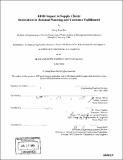RFID impact in supply chain : innovation in demand planning and customer fulfillment
Author(s)
Mei, Qiang Rose, 1973-
DownloadFull printable version (5.681Mb)
Alternative title
Radio Frequency Identification impact in supply chain
Other Contributors
Massachusetts Institute of Technology. Engineering Systems Division.
Advisor
Abbott Weiss and Chris Caplice.
Terms of use
Metadata
Show full item recordAbstract
(cont.) hand inventory. The key of RFID implementation is to broaden the collaboration with retailers. This thesis discusses the vertical relationship between vendors and retailers in both the barcode and Radio Frequency Identification (RFID) enabled environments. Its purpose is to find best practice in demand planning and customer fulfillment for vendors to improve customer service and reduce cost. Interviews were used to collect the information about current processes. A model was built to simulate the customer demand and inventory record accuracy, and this tool was used to analyze the different processes of demand planning and customer fulfillment. The results show that, in order to improve the shelf availability and reduce cost, suppliers may consider (1) using Point of Sale (POS) data as a demand driven signal to facilitate Vendor Managed Inventory (VMI) to store level, which eliminates the retailer ordering process, and (2) monitoring the store traffic and backroom inventory by periodically checking the POS data and the information collected at the backroom-in and backroom-out points. Comparing the in-store traffic in different data points can reduce the time of out-of-stock, and reduce the possibility that products are in the backroom but not on the shelf. Retailers might still need their distribution center (DC) to reduce the transportation cost, but the retailer DC should do more cross-docking activities rather than build up inventories for stores. Retailers will receive immediate benefits from this process change. Suppliers, on the other hand, will also enjoy significant reduction in inventory and increased product availability at the store level. Increasing the replenishment frequency, reducing the overall lead-time, and collaborating on promotion plan will all have notable impacts on improving customer service level and reducing on
Description
Thesis (M.Eng. in Logistics)--Massachusetts Institute of Technology, Engineering Systems Division, 2004. "June 2004." Includes bibliographical references (p. 53-56).
Date issued
2004Department
Massachusetts Institute of Technology. Engineering Systems DivisionPublisher
Massachusetts Institute of Technology
Keywords
Engineering Systems Division.